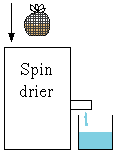Artificial (temperature controlled) pretreatment without medium for deeply or shallowly dormant tree seeds.
The advantages of this method in comparison to the “easy” and “moderate” methods are that i) the pretreatment temperatures are less susceptible to the vagaries of the weather and ii) splitting / chitting / germinating of seeds during the pretreatment is less likely to occur. The absence of the moisture containing medium prevents the cells of the least dormant seeds from absorbing this water, elongating and beginning their germination process prematurely.
- Determine prescribed cold, or warm plus cold pretreatment durations for individual species and use “Approximate date to initiate artificial pretreatment” as guide to likely start date.
- Place seeds in a woven bag and tie securely.

- Place woven bag plus seeds into a suitably sized watertight container.

Either:
- Wash in cold, running water; or
- Add at least five volumes of cold water, soak at 4 °C and change water if it becomes discoloured. Regularly withdraw bag, drain and re-submerge to allow thorough washing and removal of any chemical inhibitors.
- After 48 hours washing/soaking, drain seeds in a sieve, air– or spin–dry to obtain imbibed, surface dry, free–flowing, easily handled seeds.
- Either spin dry bagged seeds,

- Or spread moist seed into a suitably sized mesh or absorbent medium to surface dry.

- Transfer imbibed, now surface–dry seeds to a polythene bag. Leaving an air gap above the seeds, loosely tie the neck of the polythene bag with a finger sized entrance/exit hole to permit gaseous exchange but retard drying.

- Incubate for prescribed durations of cold, or warm plus cold. Use a ‘cool’ room (10 to15 °C) for the warm phase – avoid airing cupboards (too warm) and window ledges (too variable). Use the main compartment of a refrigerator for the chilling phase – avoid the icebox (too cold).
- Inspect seeds regularly (preferably weekly to fortnightly) for the following:
- Re–moisten if necessary.
- Remove decaying seeds to prevent the spread of fungal infections.
- Undertake one of the following three:
- Apply the prescribed pretreatment durations and sow (with the knowledge that the maximum germination potential of the seed lot may be sacrificed because some seeds may still be dormant); or
- Remove and sow germinating seeds at each inspection a; or
- Wait until approximately 10% of seeds have begun to split, chit or germinate and sow whole population a.
a Seed splitting/chitting/germinating is less likely to occur in this method compared to others due to the absence of a water containing medium. This prevents the cells of non-dormant seeds from imbibing, elongating and hence germinating prematurely.



